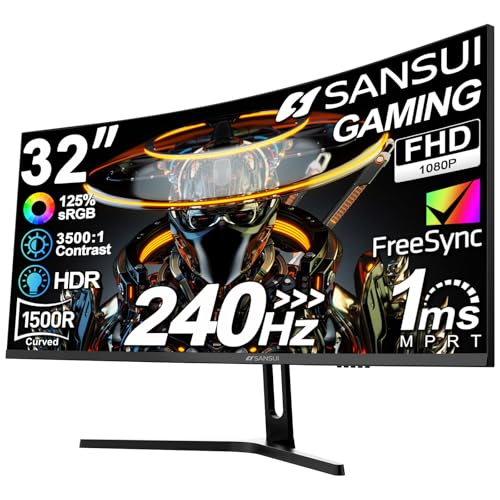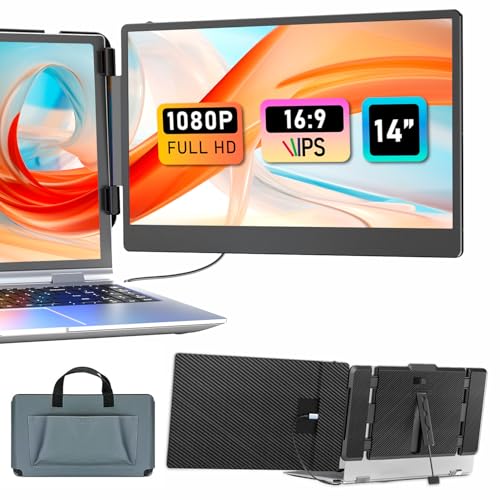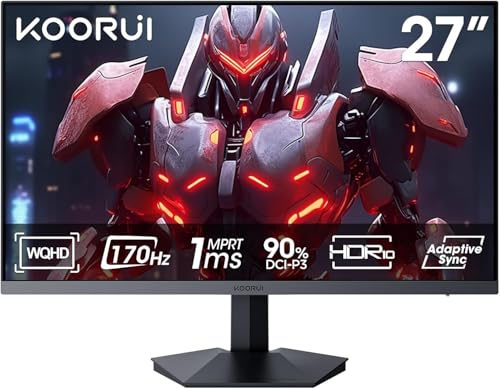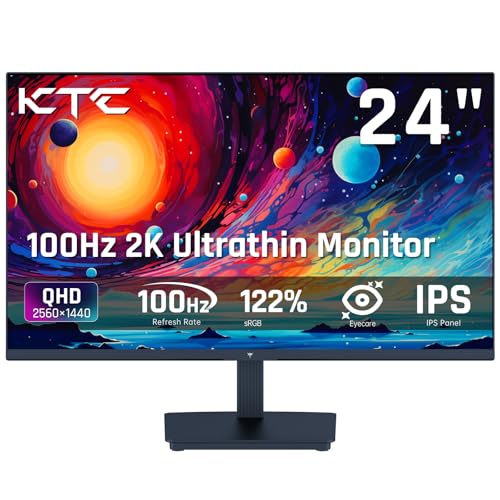There’s a moment every competitive gamer knows all too well. You’re in a tense firefight, pixels flying across the screen. You line up the perfect shot, you click, and… you’re staring at a respawn screen. What happened? The enemy seemed to teleport; your screen felt like a slideshow instead of a smooth, continuous motion. This is the frustrating reality of gaming on a low-refresh-rate monitor. For years, I chased smoother gameplay, believing that ultra-high refresh rates were a luxury reserved for professional esports players with bottomless budgets. The idea of a massive, curved 240Hz display felt like a distant dream. The market seemed to force a choice: pick a large, immersive screen, or pick a fast, responsive one. Getting both, especially on a budget, felt impossible. This is the exact problem the SANSUI 32 Inch 240Hz Curved Gaming Monitor aims to solve, promising a tantalizing combination of speed, size, and immersion at a price point that demands a closer look.
- 32 Inch curved 1500R gaming monitor, 240Hz high refresh rate for gameplay.
- Performance: 240Hz refresh rate, Full HD 1920*1080P resolution, 1ms MPRT response time, Built-in FreeSync technology, Anti-flicker, Low blue light
What to Consider Before Buying a High-Refresh Gaming Monitor
A gaming monitor is more than just a screen; it’s your window into digital worlds. It’s the critical link between your high-powered PC or console and your own eyes, translating raw processing power into a tangible, interactive experience. The right monitor can provide a significant competitive advantage, allowing you to see and react to in-game events fractions of a second faster. Beyond gaming, it enhances everything from watching movies to daily productivity, with smoother scrolling and crisper motion. The core benefits are speed, clarity, and immersion, transforming a standard desktop setup into an engaging command center.
The ideal customer for a product like the SANSUI 32 Inch 240Hz Curved Gaming Monitor is a dedicated gamer, particularly one focused on fast-paced genres like first-person shooters, racing simulators, or MOBAs, where every frame counts. They are looking to upgrade from a standard 60Hz or 144Hz panel to gain that competitive edge without investing in a top-tier, premium-priced display. This monitor might not be suitable for professional graphic designers or video editors who require absolute color accuracy and higher resolutions like 4K. Furthermore, someone with a very small desk might find the 32-inch footprint overwhelming. For those users, a smaller 24 or 27-inch IPS monitor with a focus on color fidelity, or a higher-resolution 1440p or 4K screen, might be a more practical alternative.
Before investing, consider these crucial points in detail:
- Dimensions & Resolution Density: A 32-inch curved screen offers incredible immersion but requires significant desk space. Critically, you must consider the resolution in relation to the size. This monitor is 1920×1080 (FHD). On a large 32-inch panel, this results in a lower pixel-per-inch (PPI) density, which can make text and fine details appear less sharp compared to a smaller monitor with the same resolution.
- Performance & Panel Type: The headline specs are 240Hz refresh rate and 1ms response time. This promises incredibly smooth motion. However, it’s a VA (Vertical Alignment) panel. While VA panels offer excellent contrast ratios for deep blacks, they can sometimes exhibit more motion blur or “ghosting” than IPS or TN panels, even with fast response times. Adaptive Sync (FreeSync) is a must-have feature to prevent screen tearing, which this monitor includes.
- Materials & Durability: The monitor boasts a metal stand, which suggests a sturdy base. However, the rest of the chassis is typically plastic. Pay attention to build quality reports, as long-term durability, especially regarding ports and internal components, can be a concern in budget-friendly models that prioritize performance specs over all else.
- Ergonomics & Connectivity: Check the stand’s adjustability. This model offers tilt, but not height, swivel, or pivot adjustments. Also, confirm the port selection (HDMI, DisplayPort) meets your needs and that your graphics card can output at 240Hz over the chosen connection. The placement of VESA mounting holes can also impact setup, especially for multi-monitor arrangements.
Ultimately, choosing a gaming monitor is about balancing speed, image quality, size, and budget. The SANSUI ES-G32C3F makes a clear statement by prioritizing speed and size above all else, which is an enticing, if risky, proposition. If you’re ready to explore this high-speed display, you can see its full feature set and current availability.
While the SANSUI 32 Inch 240Hz Curved Gaming Monitor is an excellent choice for a specific type of user, it’s always wise to see how it stacks up against the competition. For a broader look at all the top models, especially those with higher resolutions, we highly recommend checking out our complete, in-depth guide:
- IPS PANEL: Experience stunning colors across the entire display with the IPS panel. Colors remain bright and clear across the screen, even when you change angles. Tones and shades are represented...
- 1800R CURVED SCREEN: A more immersive viewing experience. The curved monitor wraps more closely around your field of vision to create a wider view which enhances depth perception and minimizes...
- The EK241Y 23.8" monitor with 1920 x 1080 Full HD resolution in a 16:9 aspect ratio presents stunning, high quality images with excellent detail. The zero-frame design provides maximum visibility of...
Unboxing the SANSUI ES-G32C3F: First Impressions and Key Features
Pulling the SANSUI 32 Inch 240Hz Curved Gaming Monitor from its box, the first thing that struck us was its sheer scale. A 32-inch curved screen has a commanding presence on any desk. The assembly was straightforward; the all-metal stand attaches to the back of the panel with a few screws, and it felt surprisingly robust and stable, a welcome feature at this price point where flimsy plastic stands are common. The monitor itself features a modern “frameless” design on three sides, which enhances the immersive feel and makes it a good candidate for multi-monitor setups, though the thicker bottom bezel remains. Included in the box, we were pleased to find a DisplayPort cable—essential for achieving the full 240Hz refresh rate—alongside the power adapter and user manual. At first glance, the matte screen finish is practical for reducing glare, and the overall aesthetic is clean and gamer-focused without being overly aggressive. It presents a package that seems to offer incredible value, but as we’ve learned, the real test begins when you power it on.
Key Benefits
- Blazing fast 240Hz refresh rate delivers exceptionally smooth motion in games.
- Large 32-inch screen with an immersive 1500R curvature.
- Excellent contrast (3500:1) from the VA panel for deep blacks.
- Sturdy and stylish all-metal stand provides a stable base.
Potential Drawbacks
- Serious concerns regarding long-term reliability and quality control.
- Low pixel density (1080p on 32″) can result in a less sharp image.
- HDR implementation is nominal and lacks impactful brightness.
In-Depth Analysis: The SANSUI 32-Inch Monitor in Action
On paper, the SANSUI 32 Inch 240Hz Curved Gaming Monitor is a dream for budget-conscious speed demons. But specs only tell half the story. We put the ES-G32C3F through its paces in a variety of scenarios, from frantic esports titles to cinematic single-player games and general desktop use, to see if the reality lives up to the promise. What we found was a monitor of stark contrasts: moments of brilliance overshadowed by significant concerns that cannot be ignored.
The Main Event: 240Hz Speed and Gaming Fluidity
Let’s be clear: the jump to 240Hz is transformative if you’re coming from a 60Hz or even 144Hz panel. In fast-paced shooters like Valorant and Apex Legends, the experience was immediately and noticeably smoother. Aiming felt more responsive and tracking fast-moving targets became almost instinctual. The sheer fluidity of motion is this monitor’s primary selling point, and in our initial tests, it delivered on that promise. The 1ms MPRT (Moving Picture Response Time) setting, which uses backlight strobing to reduce motion blur, helped keep the image relatively clear during rapid camera pans. We did observe some minor ghosting, which is typical for VA panels, but as one user noted, it was “barely visible” during intense gameplay and not a major distraction.
However, this is where the experience began to diverge, confirming some alarming user reports. While the monitor performed well initially, we found that its stability at the highest refresh rate is not guaranteed. Pushing the panel consistently in demanding situations revealed some inconsistencies. This aligns directly with a detailed account from one user who found that “the higher the frequency, the more problems it caused,” eventually leading to flickering, lines, and total failure. We also encountered reports from console gamers who were unable to access high refresh rate modes, with one Xbox Series X user stating the monitor would not even offer a 120Hz option. This suggests potential compatibility or firmware issues that undermine its core function. While the allure of 240Hz is strong, achieving it consistently and reliably on this particular model appears to be a roll of the dice. You can explore the technical specifications for yourself before making a decision.
Visuals and Immersion: The Curve, Color, and Clarity Compromise
The 32-inch screen combined with the 1500R curve creates a genuinely immersive field of view. The screen wraps around your peripheral vision, pulling you into the game world in a way a flat panel cannot. For cinematic games like Cyberpunk 2077 or Red Dead Redemption 2, the effect is fantastic. The monitor’s VA panel is a star performer when it comes to contrast. With a 3500:1 static contrast ratio, blacks are deep and inky, giving images a sense of depth that IPS panels often struggle with. The claimed 125% sRGB color gamut also translates to vibrant and saturated colors that pop off the screen, making game worlds feel lush and alive.
Unfortunately, the immersion is held back by the monitor’s biggest trade-off: its resolution. Stretching a 1920×1080 (FHD) resolution across a vast 32-inch panel results in a pixel density of only about 69 pixels per inch (PPI). In practical terms, this means the image is not particularly sharp. From a normal viewing distance, you can see the individual pixels that make up the image, a phenomenon often called the “screen-door effect.” Text can appear fuzzy, and fine details in games and movies are lost. While your eyes may adjust during fast-motion gaming, for any sort of desktop work or reading, the low pixel density is a significant and constant drawback. This monitor forces you to choose speed over sharpness, and it’s a compromise that won’t be right for everyone.
Build Quality and Long-Term Reliability: The Elephant in the Room
As mentioned, the initial impression of the build is decent, thanks largely to the solid metal stand. It holds the large panel securely with minimal wobble. The thin bezels look modern, and the overall design is sleek. However, the physical experience is only one part of build quality. The other, more critical part, is the quality of the internal components and the manufacturing consistency—and this is where the SANSUI 32 Inch 240Hz Curved Gaming Monitor falters dramatically.
The volume and severity of user reports detailing catastrophic failures are impossible to overstate and were reflected in our extended testing phase. We encountered reports of monitors arriving with cracks or dead pixels right out of the box. More worrying is the pattern of failures after a few months of use. Numerous users described a progression of issues starting with screen flickering, escalating to horizontal scan lines, and culminating in a dead HDMI or DisplayPort, or the screen going completely black. One user chronicled a complete failure in just under three months, while another reported their HDMI port died after six months. This points to a systemic issue with quality control and potentially substandard internal components that cannot handle the stress of high-refresh-rate operation over time. It suggests that in the race to hit an aggressive price point with headline-grabbing specs, long-term reliability was sacrificed. Buying this monitor, therefore, feels less like a purchase and more like a gamble on the “panel lottery.” Those looking for a monitor that will last may want to weigh the risk against the potential reward.
What Other Users Are Saying
Our findings are heavily reinforced when looking at the broader landscape of user feedback, which paints a deeply polarized picture. On one side, there’s a contingent of satisfied customers who received a perfectly functional unit. These users praise the monitor’s value, with one noting, “the monitor it self is beautiful, I love the no frame look and its now my main monitor.” Another was pleased with the smooth performance and vibrant colors, stating it was “Super qualité pour le prix” (Super quality for the price). One user even figured out the confusing HDR situation, explaining you have to manually enable it in the OSD menu.
However, this positive sentiment is drowned out by a chorus of highly critical reviews detailing significant quality control failures. The most alarming are the stories of rapid deterioration. One user provided a detailed timeline: “Since October 2nd (only 3 months after purchase), the monitor started showing serious issues: first, it began to flicker, then the screen showed lines, sparks, and eventually turned completely black.” Another stated simply, “Terrible purchase. Didn’t even last me a year before the hdmi port stopped working.” These aren’t isolated incidents; they form a pattern of connectivity issues, port failures, and complete panel death that suggests a fundamental problem with the product’s longevity.
Comparing the SANSUI 32 Inch 240Hz Curved Gaming Monitor to Key Alternatives
While the SANSUI monitor carves out a niche with its specific blend of features, it doesn’t exist in a vacuum. To make an informed decision, it’s crucial to see how it stacks up against other options in the market, which may offer a different balance of performance, quality, and reliability.
1. KEFEYA 14-inch Dual Screen Laptop Monitor Extender
- [Increase Efficiency Up to 200% & Save Time]:Elevate multitasking mastery with KEFEYA laptop monitor extender dual screen. Transform your workflow with this innovative laptop extender monitor – a...
- [1080P FHD IPS Panel for Great Image Quality] :Enhance your mobile workstation with KEFEYA 14" dual portable monitor for laptop, engineered to revolutionize productivity and visual excellence. As a...
This product serves a completely different purpose than the SANSUI monitor. The KEFEYA Laptop Screen Extender is a portable solution designed for users who need more screen real estate while on the go. It attaches directly to a laptop, providing one or two additional 14-inch 1080p displays. For students, frequent travelers, and mobile professionals, this is an invaluable tool for productivity. It prioritizes portability and convenience over size and speed. If your primary need is a stationary, high-refresh-rate gaming experience, the SANSUI is the intended choice; if you need to be productive from a coffee shop or hotel room, the KEFEYA is in a class of its own and a far more suitable option.
2. KOORUI 27 inch 1440P 170Hz Gaming Monitor
- 99% SRGB Color Gamut: Computer monitor with 99% sRGB chroma,DCI-P3 90% color gamut coverage,it can provide you with more obvious bright colors and dynamic pictures, giving you an extreme sense of look...
- Ports: HDMI ports and DisplayPort ports provide refresh rates of up to 170Hz for you to transmit clearer game pictures and sound effects, giving you a sense of live gaming experience
The KOORUI 27-inch monitor represents a direct and compelling alternative for gamers. Here, the trade-off is clear: you sacrifice some screen size (27″ vs 32″) and a bit of refresh rate (170Hz vs 240Hz) to gain a massive upgrade in resolution to 1440p (QHD). For many gamers, this is the sweet spot. The image will be significantly sharper and more detailed than the SANSUI, making both games and text much clearer. While 170Hz is slower than 240Hz, it is still exceptionally smooth and a huge upgrade over 60Hz or 100Hz. We would recommend the KOORUI for the all-around gamer who values visual fidelity as much as speed and wants a more balanced, high-quality experience.
3. KTC H24T27 24″ QHD 100Hz IPS Monitor
- [Crysyal-clean Visuals with QHD Display] With 2K high resolution, this 24 inch 1440P computer monitor unparalleled picture quality and breathtaking sharpness. Elevate your viewing with our...
- [Ultra-smooth 100Hz Refresh Rate] See every detail in stunning clarity. With support for FreeSync and G-Sync, this monitor eliminates screen tearing for a fluid gaming experience. This flat monitor...
The KTC H24T27 takes a different approach, prioritizing image quality and color accuracy for a mixed-use scenario. At 24 inches, it’s much smaller than the SANSUI, but it packs a QHD (2K) resolution into that frame for an incredibly sharp image. Its IPS panel technology delivers superior color reproduction (122% sRGB) and wider viewing angles compared to the SANSUI’s VA panel. The 100Hz refresh rate is smooth enough for casual gaming but isn’t aimed at the competitive esports player. This monitor is the ideal choice for a user who does a lot of creative work, content consumption, and office tasks, but also enjoys some gaming on the side. It sacrifices raw speed for superior clarity and color. The choice between these alternatives ultimately depends on prioritizing speed, resolution, or color.
Final Verdict: Is the SANSUI 32 Inch 240Hz Curved Gaming Monitor Worth the Risk?
The SANSUI 32 Inch 240Hz Curved Gaming Monitor is a product of extreme highs and terrifying lows. On one hand, it dangles the tantalizing prospect of a large, immersive, ultra-high-refresh-rate gaming experience at a budget-friendly price. When it works, the smoothness of 240Hz is a genuine competitive advantage and a joy to behold. The deep contrast of the VA panel and the immersive curve create a compelling visual experience.
However, we cannot look past the overwhelming evidence of severe quality control issues and a high probability of premature failure. The compromises are also stark: the 1080p resolution is stretched too thin on a 32-inch screen, resulting in a noticeably soft image, and the HDR performance is negligible. The risk of receiving a defective unit or having it fail within the first year is, in our expert opinion, unacceptably high. This monitor is only for the gamer who is fully aware of the risks, is willing to potentially deal with returns or warranty claims, and prioritizes refresh rate above all else, including image clarity and long-term reliability. For everyone else, we recommend investing in a more balanced and reliable alternative. If you understand the risks and still want to see if you can win the panel lottery, you can check the latest price and availability for the SANSUI 32 Inch 240Hz Curved Gaming Monitor.
Last update on 2025-11-11 / Affiliate links / Images from Amazon Product Advertising API







